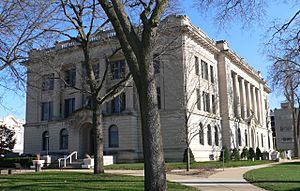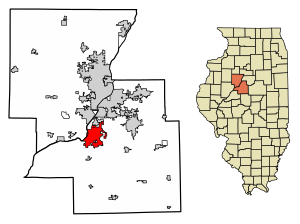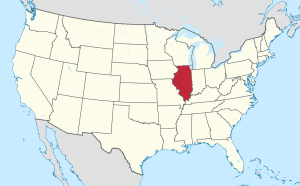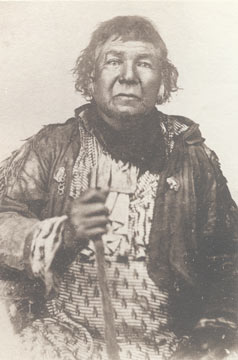Pekin, Illinois facts for kids
Quick facts for kids
Pekin
|
|||
|---|---|---|---|

Tazewell County Courthouse
|
|||
|
|||
| Motto(s):
"Community' Opportunity' Home"
|
|||

Location of Pekin in Tazewell and Peoria counties, Illinois
|
|||

Location of Illinois in the United States
|
|||
| Country | United States | ||
| State | Illinois | ||
| Counties | Tazewell; Peoria (small portion) | ||
| Townships | Pekin, Hollis | ||
| Named for | Beijing, China | ||
| Area | |||
| • City | 16.57 sq mi (42.91 km2) | ||
| • Land | 15.72 sq mi (40.71 km2) | ||
| • Water | 0.85 sq mi (2.20 km2) | ||
| Elevation | 538 ft (164 m) | ||
| Population
(2020)
|
|||
| • City | 31,731 | ||
| • Density | 2,019/sq mi (5,229.19/km2) | ||
| • Metro | 402,391 | ||
| Time zone | UTC−6 (CST) | ||
| • Summer (DST) | UTC−5 (CDT) | ||
| ZIP Code(s) |
61554
61555 (P.O. Boxes only) |
||
| Area code(s) | 309 | ||
| FIPS code | 17-58447 | ||
| GNIS feature ID | 2396172 | ||
Pekin (/ˈpiːkɪn/ PEE-kin) is a city in Illinois, USA. It is the main city of Tazewell County. Pekin is located on the Illinois River. It is the second largest city in the Peoria metropolitan area, right after Peoria.
In 2020, about 31,731 people lived in Pekin. A small part of the city is also in Peoria County. Pekin is a suburb of Peoria and is part of the larger Peoria Metropolitan Statistical Area.
Pekin has a place called Mineral Springs Park. It is close to Pekin Hospital. The city is also home to a large building for retired workers from the United Auto Workers. The Pekin Federal Prison is here too. Pekin Insurance, a big regional company, has its main office in Pekin.
Contents
History of Pekin
How Pekin Began
The first non-Native American person to live where Pekin is now was Jonathan Tharp. He was a farmer from Ohio. In 1824, he built a log cabin near the Illinois River. Other settlers, like his father Jacob Tharp, joined him soon after.
They lived near a large Native American village. This village had about 100 wigwams. It was home to the Potawatomi tribe, led by Chief Shabbona. The village was on the eastern shore of what is now Pekin Lake.
In 1827, William Hodge surveyed the land for a "town site." In 1829, the land was sold. Major Isaac Perkins, Gideon Hawley, William Haines, and Major Nathan Cromwell bought it. Major Cromwell's wife, Ann Eliza Cromwell, chose the name Pekin. She thought Beijing, China, was on the exact opposite side of the world from the new town. In the 1800s, people believed China and the United States were antipodes. This means they were directly opposite each other on the globe. So, towns were sometimes named after their supposed opposite locations.
Nathan Cromwell named many city streets after the wives and daughters of early settlers.
Pekin in the 1800s
Pekin's first post office opened on February 20, 1832. In July 1834, Pekin had a cholera outbreak. Many early settlers died and were buried in the old Tharp cemetery. There was also a scarlet fever outbreak in the winter of 1843-1844.
Before the Civil War
Nance Costley lived in Pekin. She was the first enslaved person freed with help from Abraham Lincoln. She was brought to Pekin in 1827. After her owner died, her case went to court.
Abraham Lincoln argued her case in 1841 at the Illinois Supreme Court. He used the Illinois Constitution to show she should be free. The court agreed, saying that in Illinois, "every person is free." After this, Nance stayed in Pekin with her family.
Lincoln later attended a political meeting in Pekin in 1843. He was elected to Congress in 1846. This was his only time in Washington before becoming president.
Even though Illinois was a "free" state, many people in central Illinois supported slavery. This included people in Pekin. However, some people in Pekin were against slavery. Dr. Daniel Cheever helped enslaved people escape through the Underground Railroad. The brothers Samuel and Hugh Woodrow also worked against slavery. Many German immigrants who arrived after 1848 also opposed slavery.
During the Civil War
During the American Civil War, people in Pekin had different views. Some supported the Confederacy and slavery. Others supported the Union and wanted to end slavery.
To support the Union, Dr. Cheever and ten other men started the first group of the Union League of America in Pekin in 1862. Their goal was to encourage loyalty to the Union and to end slavery. This group helped counter people who were losing hope in President Lincoln. Many anti-slavery Germans in Pekin joined the Union League.
German Settlers in Pekin
After the Revolutions of 1848 in Europe, many people from the German Confederation moved to the United States. In the 1850s, the number of German-born people in Pekin grew a lot. By 1860, about 22% of Pekin's population was from Germany.
Many German citizens became important in Pekin. Frederick P. Siebens was a director at a large factory. John Herget became Mayor of Pekin in 1873 and 1874. His brother, George Herget, was president of several companies. The historic Carl Herget mansion is now a famous landmark.
Before World War I, German was a second language in Pekin. Some stores had signs saying "German Spoken Here." Some churches even held services in German.
Railroad Arrives
The St. Louis, Peoria and Northern Railway built a train line into Pekin in 1898. They also built the Pekin Depot.
Pekin in the 1900s
The Pekin Federal Building was built in 1906. It held government offices, including the post office. The post office moved in 1966.
Civil Rights Era
Pekin had a reputation as a "sundown town." This meant it was not welcoming to black residents. Few black people lived there.
However, some church leaders in Pekin took part in the civil rights marches of the 1960s. Also, U.S. Senator Everett Dirksen from Pekin was very important. He helped pass the Civil Rights Act of 1964. This law made it illegal to discriminate based on race.
Pekin in the 2000s
In 1995, Pekin was the first city in Illinois to create a special rule to protect its groundwater. In 2011, Laurie Barra became the first female mayor of Pekin.
Geography and Climate
Pekin covers about 15.14 square miles (39.2 km2). Most of this is land, and a small part is water. Pekin is located on the Illinois River. The John T. McNaughton Bridge connects Pekin to a small area in Peoria County.
Other towns nearby include North Pekin, Marquette Heights, and South Pekin.
Pekin's Climate
Pekin has a hot-summer continental climate. This means summers are warm and humid. Sometimes there are heat waves. Winters are cold and snowy, but there are also clear days. Rain and snow fall evenly throughout the year. July is the warmest month, and January is the coolest.
| Climate data for Pekin, Illinois, 1991–2020 normals | |||||||||||||
|---|---|---|---|---|---|---|---|---|---|---|---|---|---|
| Month | Jan | Feb | Mar | Apr | May | Jun | Jul | Aug | Sep | Oct | Nov | Dec | Year |
| Mean daily maximum °F (°C) | 33 (1) |
38 (3) |
51 (11) |
63 (17) |
74 (23) |
83 (28) |
86 (30) |
84 (29) |
78 (26) |
65 (18) |
50 (10) |
38 (3) |
62 (17) |
| Mean daily minimum °F (°C) | 17 (−8) |
21 (−6) |
31 (−1) |
42 (6) |
52 (11) |
62 (17) |
66 (19) |
64 (18) |
56 (13) |
44 (7) |
33 (1) |
23 (−5) |
43 (6) |
| Average precipitation inches (mm) | 2.1 (53) |
1.9 (48) |
2.7 (69) |
3.9 (99) |
4.7 (120) |
3.7 (94) |
3.5 (89) |
3.3 (84) |
3.5 (89) |
3.2 (81) |
2.7 (69) |
2.2 (56) |
37.4 (951) |
| Average relative humidity (%) | 81 | 81 | 74 | 74 | 77 | 67.3 | 84 | 81 | 74 | 69 | 72 | 78.0 | 76.0 |
| Source: National Oceanic and Atmospheric Administration | |||||||||||||
Pekin's Population
| Historical population | |||
|---|---|---|---|
| Census | Pop. | %± | |
| 1850 | 1,678 | — | |
| 1860 | 3,467 | 106.6% | |
| 1870 | 5,696 | 64.3% | |
| 1880 | 5,993 | 5.2% | |
| 1890 | 6,347 | 5.9% | |
| 1900 | 8,420 | 32.7% | |
| 1910 | 9,897 | 17.5% | |
| 1920 | 12,086 | 22.1% | |
| 1930 | 16,129 | 33.5% | |
| 1940 | 19,407 | 20.3% | |
| 1950 | 21,858 | 12.6% | |
| 1960 | 28,146 | 28.8% | |
| 1970 | 31,375 | 11.5% | |
| 1980 | 33,967 | 8.3% | |
| 1990 | 32,254 | −5.0% | |
| 2000 | 33,857 | 5.0% | |
| 2010 | 34,094 | 0.7% | |
| 2020 | 31,731 | −6.9% | |
| U.S. Decennial Census | |||
In 2020, Pekin had 31,731 people living in 13,706 households. About 22.6% of households had children under 18. The average age in the city was 41.5 years.
Most people in Pekin are White (92.9%). About 3% are African American. About 2.6% of the population is Hispanic or Latino.
The average income for a household in Pekin was $50,838. About 15% of the population lived below the poverty line. This included 19.1% of those under 18.
Economy and Work
Coal Mining in Pekin
Coal formed in this area about 300 million years ago. Dead plants were buried and pressed over time to create coal. Coal was cheaper than wood and gave more energy. So, mining it became very popular and profitable.
Pekin had at least four coal mines:
- Pekin Coal Mine
- Regal Coal Mine
- Tazewell Coal Mine
- Ubben Coal Mine
The Ubben Coal Mine started in 1900. It produced over 2 million tons of coal until it closed in 1925. Another Ubben mine produced over 1.2 million tons.
The Pekin Coal Mining Company owned a large mine from 1939 to 1952. This mine was located under some schools. By 1951, coal mining in Pekin had mostly ended.
The Regal Coal Mine operated from 1920 to 1924. It produced over 100,000 tons of coal.
Today, the Federal Bureau of Prisons runs the Federal Correctional Institution, Pekin in the city.
Arts and Culture
Marigold Festival
The Marigold Festival is a yearly event in Pekin. It started in 1973 to honor Everett Dirksen. He was a senator from Pekin. While in Congress, Dirksen tried to make the marigold the national flower.
To support him, the people of Pekin started growing marigolds. Even though the marigold did not become the national flower, Pekin became known as the "Marigold Capital of the World."
The Marigold Festival happens on the first weekend after Labor Day in September. It includes a parade, the crowning of Miss Marigold, live music, and an arts and crafts fair.
Pekin Public Library
Pekin's library started with the Ladies Library Association. They wanted to collect books and encourage reading. The library grew quickly and moved twice. In 1896, the city council made it a free public library.
In 1900, the library board asked Andrew Carnegie for help. He was a rich person who funded libraries across the country. With land donated by George Herget and $15,000 from Carnegie, a new library was built in 1902.
The library kept growing. The Carnegie library building was taken down in 1974 to build a larger one. This new building opened in September 1974.
In 1973, President Richard Nixon visited Pekin. He dedicated the cornerstone of the new library.
Parks and Recreation
The Pekin Park District is the second largest in the region. It has 2,277 acres (921 ha) across 13 parks. It is the fifth largest park district in Illinois.
The most famous park is Mineral Springs Park. It has a restored pavilion. This 220 acres (89 ha) park has a lagoon for fishing and paddle boats. It also has sports fields, a skating rink, a skateboard park, Dragonland Water Park, miniature golf, and a dog park.
McNaughton Park offers hiking trails, a disc golf course, and horse trails. Riverfront Park has a viewing platform along the Illinois River.
Pekin also has two golf courses, Parkview and Lick Creek. There is also a country club. The city has a 4.3 mi (6.9 km) bike trail for cycling.
Education in Pekin
Most of Pekin is in Pekin Public School District 108. Other parts are in North Pekin-Marquette Heights School District 102 and Rankin Community School District 98. All students in Tazewell County parts of Pekin go to Pekin Community High School District 303.
Pekin Public Schools District 108 has:
- Six elementary schools
- Two intermediate schools
- Two junior high schools
- The Pekin Technical Education Center
Pekin Community High School (PCHS) is the only high school. It serves students from Pekin and nearby areas like South Pekin and Marquette Heights.
The part of Pekin in Peoria County is in the Hollis Consolidated School District 328 and the Limestone Community High School District 310.
Pekin Community High School History
The first high school building was built in 1915. It was expanded many times as more students joined. In 1959, the city planned to widen a street. This meant the original school could not expand anymore.
So, the school district decided to build a second campus in 1962. Classes started there in 1964. The original building became West Campus for freshmen and sophomores. The new building became East Campus for juniors and seniors.
East Campus was expanded in 1997–1998. After that, West Campus closed. All four grades were reunited at the newer East Campus. The original school building was torn down between 2012 and 2014.
Media and News
Pekin has a daily newspaper called the Pekin Daily Times. It was founded in 1873 as a weekly paper. In 1881, it became a daily newspaper. It has been published Monday through Saturday ever since.
City Services
CityLink provides bus service in Pekin. Routes 17, 18, and 23 connect Pekin to downtown Peoria and other places.
The Pekin Municipal Airport is a public airport owned by the city. It is located about four nautical miles (4.6 mi; 7.4 km) south of Pekin's main business area.
Notable People from Pekin
Many interesting people have come from Pekin, Illinois. Here are a few:
- Scott Altman (1959–), an astronaut who traveled to space.
- Sol Bloom (1870–1949), a US Congressman and music publisher.
- Erik Brann (1950–2003), a guitarist for the band Iron Butterfly.
- Hank Bruder (1907–1970), a football player for the Green Bay Packers.
- Susan Dey (1952–), an actress known for The Partridge Family.
- Everett McKinley Dirksen (1896–1969), a famous congressman and senator.
- Head East, a 1970s rock band known for "Never Been Any Reason."
- Larry Kenney (1947–), a voice actor and radio host.
- Seth Kinman (1815–1888), a mountain man.
- Danny Lloyd (1975–), an actor known for The Shining.
- John T. McNaughton (1921–1967), a Harvard Law School professor.
- D. A. Points (1976–), a PGA Tour golfer.
- Sandra Steingraber (1959–), a biologist and science writer.
Images for kids
See also
 In Spanish: Pekin (Illinois) para niños
In Spanish: Pekin (Illinois) para niños





